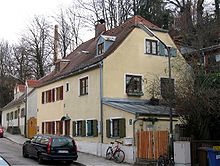Nockherstrasse
| Nockherstrasse | |
|---|---|
| Street in Munich | |
| Nockherstrasse house numbers 25–29 | |
| Basic data | |
| State capital | Munich |
| Borough | Au-Haidhausen |
| Created | in the 15. century |
| Hist. Names | Jägerhäuselgasse, at the Jägerhäuseln |
| Name received | 1876 |
| Cross streets | Am Nockherberg, Taubenstrasse, Dollmannstrasse |
| Places | Columbus Square |
| Numbering system | Orientation numbering |
| Buildings | Residential houses |
| Subway stations | U1, U2, U7 & U8 |
| use | |
| User groups | Pedestrian traffic , bicycle traffic , individual traffic |
| Road design | Asphalt road |
| Technical specifications | |
| Street length | 49 m |
The Nockherstraße is located south of the fifth municipality of Munich , Au-Haidhausen , in the former suburb of Au in the original flood plain of the Isar . The 500 meter long street runs between the end of Ohlmüllerstraße (beginning of the street Am Nockherberg ) and Columbusplatz at the foot of the Isar high bank. Around 400 people live on Nockherstrasse.
history
The nucleus of the street were two mills on the Auer Mühlbach , which go back to the 15th century, and buildings for the hunting staff of the nearby electoral falconry with the inn "Zum Jägerwirt". The original name of the street was Jägerhäuselgasse or Bei den Jägerhäuseln , as can be seen from the official directory of house numbering in the Au suburb of 1857. In 1876 the street was renamed Nockherstraße after the socially committed Nockher family, whose small castle stood on today's Nockherberg.
At the beginning of the 19th century (verifiably from 1813, as can be seen from the plans of various house files), a dense development with so-called hostel houses was built on the slope side. In the northern part of the street the farm fishery settled with five fish ponds. Agriculture was on the decline in the mid-19th century. In addition to the agricultural land, ponds and cattle stables, production facilities were established, initially one of the largest bed spring factories in southern Germany and, after the Second World War, a Rohde & Schwarz branch . The transition from agriculture to craft and industry went hand in hand with the incorporation of the village of Au into the city of Munich in 1854 (royal order of May 17, 1854).
From around 1860 onwards, the western side of the street opposite was gradually built on with apartment buildings. There were also four inns and a sauerkraut factory. Right next to the industrial quarter, dairy farming and pig breeding was still practiced on some properties well into the 20th century. Up until 1979 there was a poultry farm and a fish shop.
During the Second World War, a large part of the houses was destroyed and not rebuilt on the slope side in favor of a planned green corridor. Today only a few of the hostel houses, which have now been equipped with modern equipment, are still there as contemporary witnesses. The apartment buildings on the side facing away from the slope were rebuilt from the 1960s in the style of the respective time and are gradually being converted into condominiums.
Previous establishments
- House number 2–4: Fisheries from the middle of the 16th century to the 19th century - afterwards the cheap home and Einstein bed spring factory, Aryanized in 1934 . After the war: Rohde & Schwarz stamping shop, then Kaut-Bullinger headquarters until 1992 . Today an office complex with the German Youth Institute as a tenant.
- House number 7: farm
- House number 26: the historic inn Zum Jägerwirt
- House number 40: Sauerkraut factory Braun & Wagner
Current operations
- House number 38: Hotel am Nockherberg
- House number 48 (later: 50): Kunstschmiede Nüssel
Transport links
- U1, U2 and U7 ( Columbusplatz station )
- Bus line 52 (Taubenstraße stop)
- Bus line 58 (stop at Columbusplatz)
literature
- Peter Klimesch: Down in the green meadow. The Nockherstrasse through the ages. Norderstedt 2014, ISBN 978-3-7357-4929-1
- Department of Architecture at the Munich University of Applied Sciences (ed.): The small houses on Nockherstrasse in Munich-Untergiesing . Munich 1979.
- Josef Freudenberger: From the history of the Au. Munich 1927
- City of Munich (Ed.): Au Giesing Haidhausen 100 years near Munich. Munich 1954
- Peter Klimesch: Pictures from the old meadow. Nockherberg, Nockherstrasse. first edition. Books on Demand, Norderstedt 2015, ISBN 978-3-7392-0605-9 .
- Peter Klimesch: Pictures from the old meadow. Nockherberg, Nockherstrasse, Columbusplatz. second, revised edition. Books on Demand, Norderstedt 2016, ISBN 978-3-7431-1333-6 .
Individual evidence
- ^ "The new house numbering in the suburb of Au. Official directory, 1857 “(Munich City Archives: street name no. 16)
- ↑ stores Document of the local Commission in Munich City Archives
- ↑ Wolfgang Dölker, “The right to lodge in the Münchner Au”. Munich 1969
- ↑ stores Document of the local Commission in Munich City Archives
- ↑ Wolfram Selig , "Aryanization in Munich". Berlin 2004. ISBN 3936411336 . Aryanization of the bed spring factory

